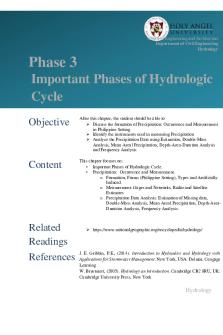GEOL201 Hydrology - Groundwater PDF

| Title | GEOL201 Hydrology - Groundwater |
|---|---|
| Course | Internal Processes of the Earth |
| Institution | University of Regina |
| Pages | 3 |
| File Size | 115 KB |
| File Type | |
| Total Downloads | 52 |
| Total Views | 144 |
Summary
Osman Salad Hersi...
Description
November 24th excess discharge and the intrusion of salt water pumping lowers the pressure of the freshwater, allowing the saltwater margin to move inland this movement creates both a cone of depression.. and an inverted cone of depression that brings salty water into the well. a well that formerly pumped fresh water now pumps salty water Speed of groundwater flows: permeability and water table gradient (slope) hydraulic gradient: ratio between the elevation difference and the flow distance (h/l)
Darcy's law Q = A (K ×h/l) the volume of water flowing in a certain time (Q) is proportional to the cross-sectional area of the aquifer through which the volume of water flows (A), the hydraulic conductivity (K) and the hydraulic gradient (h) Hydraulic conductivities vary among different materials: clay = 0.001
Erosion by Groundwater Features: • Caves and caverns ◦ Stalactites and stalagmites • Karst features (karst topography) ◦ Sinkholes characteristics of areas with karst • High rainfall and abundant vegetation • limestone bedrock with joints • significant hydraulic gradient Water Quality Lead pollution: industrial process that releases lead into the atmosphere -> rain Radioactive wastes: buried; leaches into aquifers Micro-organisms in water: residential septic tanks Other chemical contaminants: chlorinated solvents, mercury, road salt, pesticides, herbicides Human Contamination: home use, industrial chemicals, landfill dump, pumping wells Hydrology and Climate Warms areas with frequent rain = abundant water Warm arid/semiarid regions = rare rain & less water Icy climates = meltwaters from snow and ice Alternating seasons of dry and wet (monsoons) = changing water supplies Key climate factors: • relative humidity; amount of water vapour in the air, expressed as a % of total amount of water the air could hold at that temperature if saturated • warm air can hold more water vapour than cold air
• rainfall, when unsaturated warm air at a given relative humidity cools enough it becomes supersaturated and some of the vapour condenses into water droplets...
Similar Free PDFs

GEOL201 Hydrology - Groundwater
- 3 Pages

Gl102 groundwater
- 4 Pages

GEOL0055 Groundwater Quiz
- 1 Pages

Hydrology Midterm Study Guide
- 2 Pages

15 chapter 6 groundwater exploration
- 16 Pages

Chow's Handbook of Applied Hydrology
- 46 Pages

Hydrology- Module 1- Phase 3
- 23 Pages
Popular Institutions
- Tinajero National High School - Annex
- Politeknik Caltex Riau
- Yokohama City University
- SGT University
- University of Al-Qadisiyah
- Divine Word College of Vigan
- Techniek College Rotterdam
- Universidade de Santiago
- Universiti Teknologi MARA Cawangan Johor Kampus Pasir Gudang
- Poltekkes Kemenkes Yogyakarta
- Baguio City National High School
- Colegio san marcos
- preparatoria uno
- Centro de Bachillerato Tecnológico Industrial y de Servicios No. 107
- Dalian Maritime University
- Quang Trung Secondary School
- Colegio Tecnológico en Informática
- Corporación Regional de Educación Superior
- Grupo CEDVA
- Dar Al Uloom University
- Centro de Estudios Preuniversitarios de la Universidad Nacional de Ingeniería
- 上智大学
- Aakash International School, Nuna Majara
- San Felipe Neri Catholic School
- Kang Chiao International School - New Taipei City
- Misamis Occidental National High School
- Institución Educativa Escuela Normal Juan Ladrilleros
- Kolehiyo ng Pantukan
- Batanes State College
- Instituto Continental
- Sekolah Menengah Kejuruan Kesehatan Kaltara (Tarakan)
- Colegio de La Inmaculada Concepcion - Cebu








